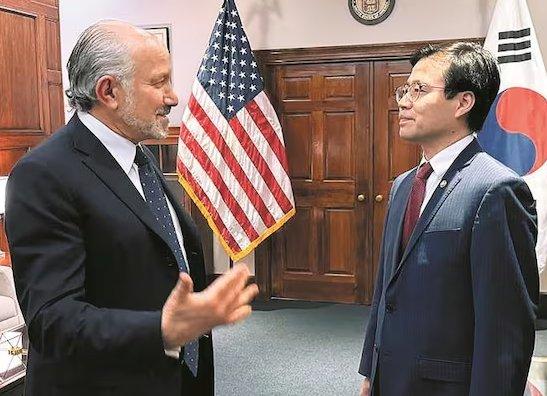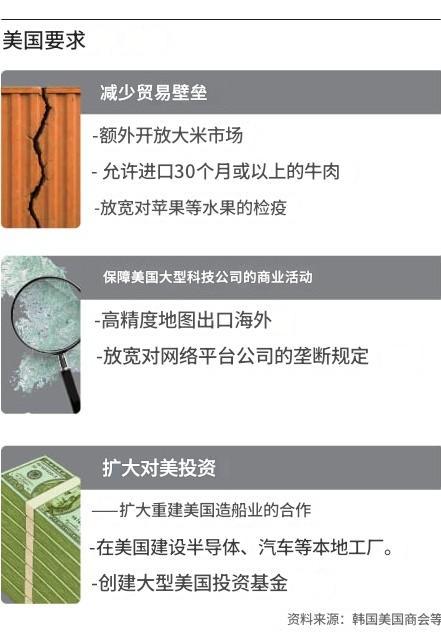

[Report by Ouanchao Net, Qi Qian] Faced with the threat of a 25% new tax rate from US President Donald Trump, South Korea urgently sought to reach an agreement before the deadline on August 1. However, according to reports by Korean media outlet Chosun Ilbo on July 15th, citing sources, the US has made demands that are “unacceptable” to South Korea, hindering progress in negotiations.
It is revealed that the US strongly requested South Korea to open its agricultural and livestock product markets, and to abolish barriers including restrictions on beef imports for products over 30 months old and strict fruit quarantine conditions. This news immediately sparked significant controversy in South Korea, with the agricultural sector fearing it would become a victim of trade negotiations.
Furthermore, sources indicated that the US demanded the establishment of a large-scale investment fund by the South Korean government for use by Korean enterprises investing in the US to support the reconstruction of American manufacturing. It is reported that this proposal is modeled after the “US-Japan Joint Sovereign Wealth Fund” initiative, with a similar amount of approximately $400 billion. The Chosun Ilbo pointed out that this staggering figure represents more than 80% of South Korea’s annual national budget, leaving the South Korean government in a dilemma about how to raise funds.
Regarding the report on establishing an investment fund, the South Korean government website issued a statement on the 16th, stating, “It is difficult to confirm whether such matters were discussed during the negotiations and the government’s stance on this issue.” The statement emphasized, “Negotiations are related to national interests, and please be cautious in reporting.”
“The US requests South Korea to establish an investment fund, following Japan’s example”
The report mentioned that on July 7th and 10th, the South Korean delegation held two high-level bilateral trade negotiations with representatives from the US in Washington. During these meetings, the US demanded that the South Korean government lead the creation of a “Manufacturing Cooperation Enhancement Fund,” which will be used by Korean enterprises to build or expand factories in the US or invest in local American companies.
A South Korean government source revealed, “During negotiations, the South Korean government prepared a variety of non-tariff barrier relaxation plans including agricultural and livestock products to minimize mutual tariffs and automobile tariffs as much as possible. However, U.S. Secretary of Commerce Loutiknick focused on the establishment of the fund.”
On July 7th, Loutiknick met with representatives from South Korea, Lu Hanjiu.
The Chosun Ilbo pointed out that this is completely different from the trade barrier relaxation measures previously requested by the United States, including opening up the market for beef and rice, and allowing Google to access precise map data. It represents a higher level of demand. As the “ultimatum” approached on August 1st, the new demands from the U.S. were interpreted as Trump wanting a clear outcome that could be presented to the American public.
It has been reported that Japan proposed a fund size of approximately $400 billion. Given the trade surplus between South Korea and Japan is comparable, the U.S. reportedly also requested South Korea to establish a fund of the same scale.
Reports indicate that there was a suggestion within the South Korean government that “U.S. Secretary of Commerce Loutiknick made proposals that South Korea could not accept, leading to difficulties in negotiation progress,” which is believed to be related to the U.S.’s request.
In May this year, The Financial Times cited sources saying that Sun Nazneen, founder of Japan’s SoftBank Group, proposed the establishment of a joint sovereign wealth fund between the U.S. and Japan for large-scale investments in the U.S. technology and infrastructure sector. It was revealed that Sun’s initial capital proposal was $300 billion, which later grew to about $400 billion.
According to Sun’s proposal, the U.S. Treasury Department and Japan’s Ministry of Finance would become co-owners and operators of the joint fund, holding substantial shares each. The joint fund would open up investment opportunities to other limited partners, and even offer shareholding opportunities to ordinary people in the U.S. and Japan.
This amounts to more than 80% of the annual national budget!
The South Korean government is concerned
On the 14th local time, during a meeting on the progress of negotiations, Lü Hanjiu, the Minister in charge of Trade and Economic Cooperation at the Ministry of Trade, Industry and Energy, stated: “Investing and purchasing high-tech equipment from the United States in shipbuilding, semiconductors, and batteries are closely related to the cooperation between the two countries’ manufacturing industries as expected by the United States.”
He also mentioned, “Decisions regarding investment or purchase of private enterprises fall within the domain of individual companies. However, the government is also committed to building a ‘platform’ behind the scenes to facilitate this process and provide support… Compared to simply reducing tariffs by a few percentage points, helping the United States rebuild its manufacturing industry and providing new growth momentum for our companies (by entering the American market), such ‘positive’ negotiations are possible.”
The Chosun Ilbo believes that Lü Hanjiu’s remarks may imply the contention that the United States is requesting the establishment of a fund. It is interpreted as the South Korean government intending to lead the establishment of funds to support South Korean companies in their ventures into the US, strengthening manufacturing cooperation, and promoting tariff reductions.
The report states that some analysts are overly optimistic, claiming that if the establishment of a fund supports the investment in manufacturing by South Korea and exchanges for the reduction of tariffs as much as possible, it would not be bad for South Korea. They claim that investing in South Korean companies’ ventures into the US not only can exchange for tariff reductions but is also crucial for the future growth of the South Korean economy against the backdrop of domestic market demand reaching its limit and global market facing competition from China.
However, there are also South Korean experts who worry that this move could accelerate the hollowing out of South Korean domestic industries.
“The issue lies with the scale of expectations from the United States,” pointed out the Chosun Ilbo. With just half a month left until August 1st, facing an amount equivalent to more than 80% of this year’s national budget, the South Korean government finds itself in a dilemma about how to raise funds.
Considering the economic size difference between South Korea and Japan and the gap in direct investments to the US, it is a sum that is difficult for the South Korean government to bear. However, if it proposes a figure significantly lower than Japan’s, it would be hard to convince the United States.
It is reported that on the 15th, the South Korean government held a meeting to discuss appropriate fund sizes, funding schemes, and investment sectors.
The newly appointed Minister of Planning and Finance and Minister of Industry, Trade, and Resources in South Korea are expected to take office soon. Upon assuming their roles, they will resume the “2+2 trade negotiations” with U.S. Treasury Secretary Steven Mnuchin and U.S. Department of Commerce Secretary Gina Raimondo as soon as possible. However, according to the “Korea Herald,” given the challenges presented by the United States, negotiations are expected to face difficulties. In the worst-case scenario, it might not be possible to reach an agreement before August 1st, the deadline.
The multiple demands made by the United States towards South Korea
“South Korean farmers and ranchers are outraged”
The “Korea Herald” reports that, according to various departments within the South Korean government, in addition to the colossal investment funds, during the South-U.S. tariff negotiation process, the United States has strongly requested South Korea to abolish non-tariff barriers in the agricultural and livestock products sector, including restrictions on the import of beef over 30 months old, strict fruit quarantine conditions, and high tariff rates of up to 513% for rice.
The report states that the United States believes South Korea is the only country globally that actually prohibits the import of “beef over 30 months old from the United States.” If South Korea relaxes these restrictions, it would have significant symbolic and economic effects, hence exerting strong pressure on the South Korean side. The United States also claims that South Korea’s quarantine procedures for fruits are too stringent, and that the tariffs imposed on American rice imports are too high.
It was introduced that around 2000, the United States faced mad cow disease outbreaks, and in 2008, a deal was reached between South Korea and the United States, setting a limit on the age of beef imports. There were even reports within the United States that if this import age limit were abolished, it could potentially bring in an additional $110 million to $175 million in revenue for the United States.
The “Korean Herald” analysis points out that before South Korea, the UK and Vietnam reached a trade agreement with the United States, deciding to import American beef and corn and wheat among other things. Consequently, South Korea is inevitably compelled to open up its agricultural product markets.
A South Korean government official told “Hankook Ilbo”: “The US is currently focusing on our request to relax restrictions on beef imports, which we must consider. If we accept this demand, the US might view us as showing sincerity.”
However, there are also concerns that while this move may satisfy President Trump, it could trigger strong domestic public backlash in South Korea.
Currently, both the Ministry of Agriculture, Forestry and Fisheries and representatives from South Korean farmers have expressed strong opposition. The “Central Federation of Post-Maize Farmers” in South Korea will hold a rally in front of the Presidential Office in Yongsan on the 16th, opposing the opening of the agricultural product market to the United States.
The report indicates that the issue of beef imports has high political sensitivity. A representative from the Ministry of Agriculture, Forestry and Fisheries stated: “The mad cow disease crisis once put great pressure on the government. If consumer concerns about the safety of beef and distrust spread, the situation may be difficult to manage.” The “National Korean Beef Association” of South Korean beef producers issued a statement, condemning the government for “seeing the suffering and sacrifices in agriculture and farming as inevitable.”
“Hankook Ilbo” reported that compared to the beef issue, expanding the market for rice to the United States and relaxing fruit quarantine is less likely. The report explained that if the quota for importing American rice is increased, South Korea would need to renegotiate with other countries like China and Vietnam for their rice quotas; and once fruit quarantine is relaxed, it could lead to irreversible risks of pests and diseases.
On the 14th, Lü Hanjiu stated at the meeting that in response to the United States’ demands to eliminate non-tariff barriers, the government will fully consult with relevant departments and the Congress to develop negotiation plans and plan to return to the United States for negotiations before August 1st.
Lü Hanjiu stated that “one should not sacrifice actual benefits for the sake of time”, but he also mentioned, “there is a need for strategic judgment in the field of agricultural products”.
The Chosun Ilbo believes this implies that the South Korean government might use the leverage of opening up the market for agricultural and pastoral products. The Hankyoreh also commented that this statement could be interpreted as the South Korean government’s potential to further expand the market access for agricultural and pastoral products.